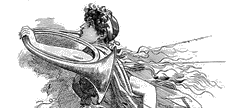|
|
 |
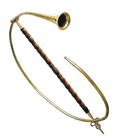
|
Maker:
Location:
Model:
Year:
|
Medieval
Arms
Germany
Roman
Cornu (repro.)
2008
|
|
|
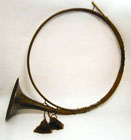
|
Maker:
Location:
Model:
Year:
|
A.S.
Germany?
Parforce
Horn in C basso
ca.
1800?
|
|
|
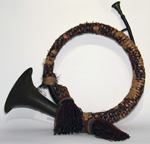
|
Maker:
Location:
Model:
Year:
|
anonymous
France
Petite
Cor de Chasse in D
ca.
1860?
|
|
|
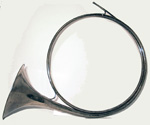
|
Maker:
Location:
Model:
Year:
|
Arsène Zöe
Lecomte
Paris,
France
Trompe
Dauphine in D
ca.
1880
|
|
|
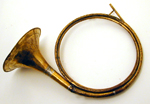
|
Maker:
Location:
Model:
Year:
|
Courcier
& Prétet
Besançon,
France
Trompe de Chasse in D
ca.
1890?
|
|
|

|
Maker:
Location:
Model:
Year:
|
anonymous
France
or Belgium
Trompe
Maricourt
ca.
1890?
|
|
|
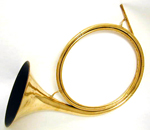
|
Maker:
Location:
Model:
Year:
|
Elless
France
Trompe
de Chasse in D
ca.
1900
|
|
|
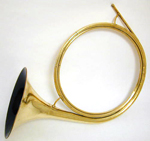
|
Maker:
Location:
Model:
Year:
|
Pélisson,
Guinot & Blanchon
Lyon-Paris,
France
Trompe
de Chasse in D
ca.
1900
|
|
|
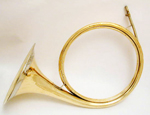
|
Maker:
Location:
Model:
Year:
|
Erste Wiener
Productiv
Vienna,
Austria
Waldhorn
in E♭
ca.
1900
|
|
|
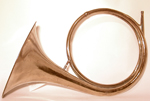
|
Maker:
Location:
Model:
Year:
|
F. Van
Cauwelaert
Brussels,
Belgium
Cor de
Chasse in C
ca.
1903
|
069 |
|
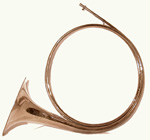
|
Maker:
Location:
Model:
Year:
|
Wolfram
Markneukirchen,
DDR
Parforce
Horn
ca.
1950
|
|
|
 |
 |
 |

|
|
At left is a Roman bronze
legionary corcine's
(horn player's) brooch in the shape of his cornu.
It dates from the 2nd to 3rd
century A.D. The diamond on the holding staff
indicates that the player was a member of the
Legio IV Flavia Felix. It was found in the Balkins
(ancient Moesia Thacia/Dacia) at a site of an
ancient battllefield or legionary
settlement. Legionary musicians were not
only the motivators going into battle, but they
also provided communications for the legions. The
Legio IV Flavia Felix was raised by Vespasian in
70 A.D. from the former Legion IV Macedonia. The
following year it moved east into Upper Moesia
(Serbia) ad Singidunum (Belgrade) to take part in
the first Dacian War (101-102) and then north into
Sarmigethusa after the second invasion of Dacia
(Hungary), 105-107. With the reign of Hadrian the
legion moved back permanently to Singidunum.
|
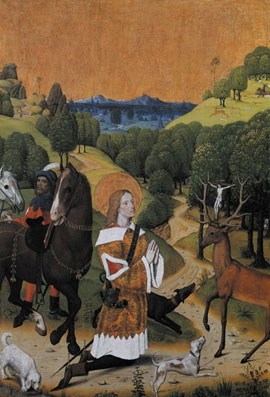
|
|
Saint
Hubert (AD 656-727) was the son of the
Duke of Aquitaine and led a wealthy and
self-indulgent life, including an ardent passion
for the chase. On Good Friday 683 he was in
the Forest of Ardennes when he found himself
facing the vision of a stag bearing a crucifix
between its antlers. This caused Hubert to
renounce his dukedom, to take holy orders and to
live for a time as a hermit in the forest, before
becoming Bishop of Tongres, then of Liège. St.
Hubert is the patron saint of the hunt, andSt.
Hubert's day is celebrated on November 3, often
with a mass performed with hunting horns. At left, "The Conversion of St
Hubert", by the Master of the Life of the Virgin,
Cologne, c.1480-85. |
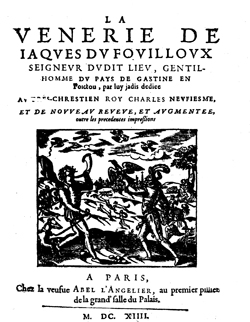
|
|
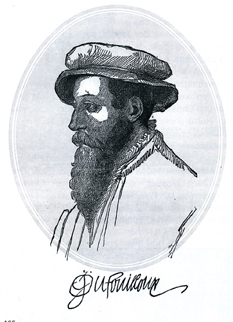
|
La
Venerie de Jacques
du Fouilloux was first published
in Poitiers in 1561. It was the first French hunt
book after the introduction of printing and was a
great success due to its clarityand logical
structure, and was illustrated with 56 woodcuts in
a simple but understandable way. It was published
in numerous subsequent editions in France and in
translation in Germany, Italy and England, the
latter as late as 1908.
|
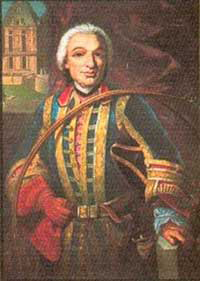
|
|
Marc-Antoine
de Dampierre was born December 24, 1676
at Pisseleu, near Saint-Omer en Chaussée. In 1722
the Duc de Gesvres named him Gentilhomme des Menus
Plaisirs du Roi. As a "gentleman of the
small delights", he was now responsible for all
royal hunts and each had a room in the castles of
Fontainebleau, Rambouillet, Compiègne and
Saint-Germain. It is said that he chose to use a
large trompe in D of 4.05 meters from the church
horns that were tested and employed by the head of
the Chapelle Royale, Andre Campra (1660 - 1744).
He is credited with establishing D as the standard
pitch for the hunt and designing the Trompe
Dampierre in collaboration with Raoux in about
1723. This is a 1.5 coil horn pitched in D
of 72.9 cm. diameter. In 1729 he designed the
Trompe Dauphine, made by Lebrun and named for the
son of Louis XV. It is a 2.5 coil horn at
the same pitch as the Trompe Dampierre but at
about two thirds the diameter. Even though this
was much easier to manage during the hunt,
Dampierre continued to use the larger horn.
|
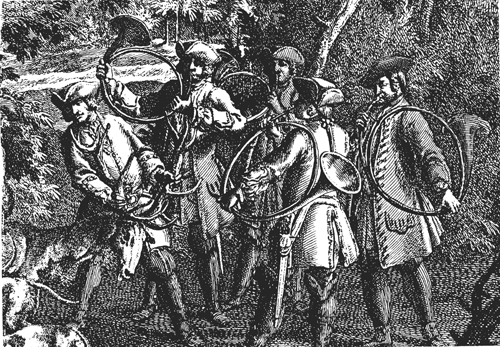
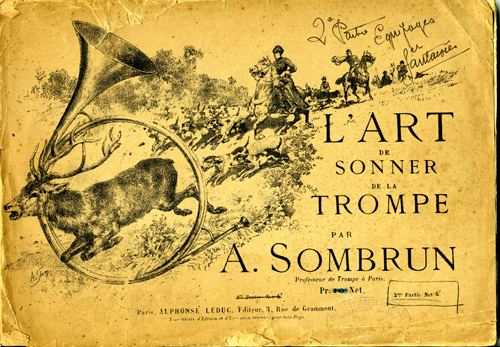
|

